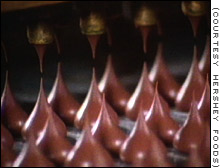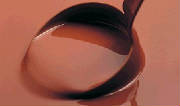|

History of Chocolate...
Chocolate has a long
history, stretching as far back to Christopher Columbus. After his fourth voyage
to the New World, Columbus returned to Spain in 1502 and introduced treasures to the court of King Ferdinand. Among the gifts were cocoa beans. Almond-shaped seeds from
the cacao tree, which is the source of all chocolate and cocoa produces made today.
Decades later, during his conquest of Mexico, Spanish explorer, Hernando Cortez, saw the Aztecs using cocoa beans to
make a drink called, Chocolatl, meaning warm liquid. The Aztec Emperor Montezuma
drank about 50 servings a day and only served the royal drink to guests in ceremonial golden goblets. Not only did they use the beans for drinks, they also used it as currency, for example, for cocoa beans
was the price for a turkey.
Cortez described chocolatl as, “the divine drink, which builds up
resistance and fights fatigue,” and his countrymen, thought of the idea of sweetening the once bitter drink with cane
sugar. With newly discovered spices like cinnamon and vanilla were also added
as flavorings.
The Spanish began to plant cacao trees but kept the processing of cocoa beans a secret. The recipe was kept for almost 100 years. Once it was out, all of Europe knew. As
first, chocolate was restricted to the nobility. In fact, the Spanish Princess
Maria Theresa presented cocoa beans as an engagement gift to Louis XIV, and soon chocolate was the rage of the fashionable
Court of France. The famous historic figure Casanova and Madame DuBarry both
believed that chocolate was conducive to romance. So popular did chocolate become
that in 1657 the first of many English "chocolate houses" was established, to serve the drink to the general public.
Chocolate arrived in the American colonies in 1765, when the first chocolate factory opened
in New England. In 1847, an English company introduced solid eating chocolate.
Now the public could enjoy chocolate in both liquid and solid form. Three decades later, at Vevey, Switzerland, Daniel Peter found that milk could be added to chocolate to
make a new product, appropriately named milk chocolate. And that’s how chocolate became what it is today.
| Cocoa Beans |

|
| Cacao tree with cocoa beans, which can get bigger the a football |
Chocolate Fact Sheet
- The average American consumes approximately 11.7 pounds of chocolate each year.
- Chocolate has less caffeine then coffee, tea, and soft drinks. Each oz of chocolate contains 6mg of caffeine. while 5
oz. of coffee contains somewhere betweem 40 and 108 mg. of caffeine.
- Some types of chocolate contains a small amount of anandamide which combins with cannabinoids in the brain and acts
simuliar to the afficts of drugs. But don't worry, one would have to eat several pounds in one day. Enough for you to get
sick before getting even the slightist bit high.
- Chocolate is America's favorite flavor. A recent survey revealed that 52 percent of U.S. adults said they like chocolate
best.
- U.S. chocolate manufacturers use about 3.5 million pounds of whole milk every day to make chocolate.
- 65 percent of American chocolate eaters prefer milk chocolate.
- The melting point of chocolate is just below the human body temperature (98.6 degrees) — which is why
it literally melts in your mouth.
- Chocolate manufacturers currently use 40 percent of the world's almonds and 20 percent of the world's peanuts.
- The largest chocolate bar ever manufactured weighed 5,026 lbs. and was exhibited by Elah-Dufour United Food Companies
at Eurochocolate in Turin, Italy in March 2000.
- The largest box of chocolates ever made was a Frango mint chocolates box weighing 3,226 lbs. created by Marshall Field's,
Chicago, Illinois, USA on November 14, 2002. The box contained 90,090 individual chocolates.
- Cocoa and chocolate are rich in minerals that the body needs, including magnesium and iron
- The estimated retail sales of chocolate in 2000 were $13 billion
- New research is finding chocolate to be packed with high-quality anti oxidants that may reduce the risk of developing
cancer and heart disease
- In 2000, the total chocolate consumption in the U.S. was 3.3 billion pounds
- All of the scientific research of chocolate addicons shows that people desire chocolate because of its aroma, creaminess
and satisfying flavor. There is no such thing as a chocolate “addiction.” (So im not a chocolate addict afterall
!!)
-
Chocolate and sweets are often blamed when children get overly wound up. But experts have found that sugar has no adverse
effects on the behavior of most children. Children tend to get excited during parties and other celebrations. The special
event, not the foods eaten, is thought to be responsible for children's increased activity and excitement.

Taste Testing Chocolate
- Flavor - well-balanced, not bitter or too sweet
- Appearance - shiny and evenly colored
- Aroma - rich and flavorful, not burned, musky or chemical in scent
- Snap - break firmly and cleanly, not crumble or splinter
- Texture/mouth feel - smooth and creamy, not waxy and gritty
- Aftertaste - should linger pleasantly

|

